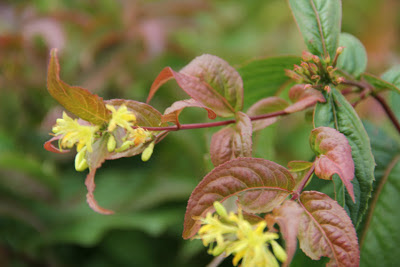Dwarf bush honeysuckle
Life-of-man
Diervilla lonicera
Three species comprise the genus Diervilla. Related to true honeysuckles (Lonicera), Northern Bush Honeysuckle is native to eastern North America. Found throughout northern boreal and hardwood forests in the deep shade of mature woods to forest openings or cut clearings in full sun or semi shade.
A low growing deciduous shrub with upright arching stems to 3’ tall. Bush Honeysuckle is a very competitive, tough shrub which can grow into dense waist- high colonies. Tolerant of many soil types and almost indifferent to pH, rampant growth happens in acidic mesic soils.
It begins blooming in late June throughout summer; the tubular yellow flowers have slight fragrance. The flowers which attract bumblebees, swallowtails and hawk moths, turn orange-pink after pollination. Individual stems last only a few years, old stems drop leaves and can be culled.Typical specimens have large green smooth, serrated, opposite leaves with woody green stems. Nurseries have plants selected for red stems and bearing young reddish foliage. Fall color is superb in red, orange, and yellow.
I grow Dwarf Bush Honeysuckle under a canopy of oak holding a steep slope. Colonies of seed grown green shrubs matched with a border of nursery purchased reddish specimens makes an eye catching year round attraction which culminates in a fall spectacle.



No comments:
Post a Comment